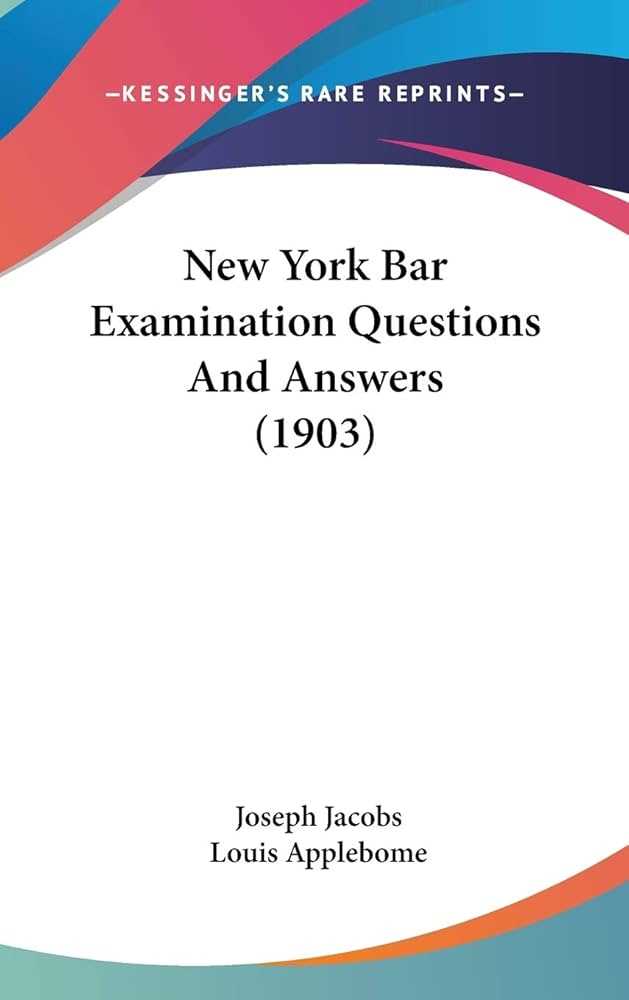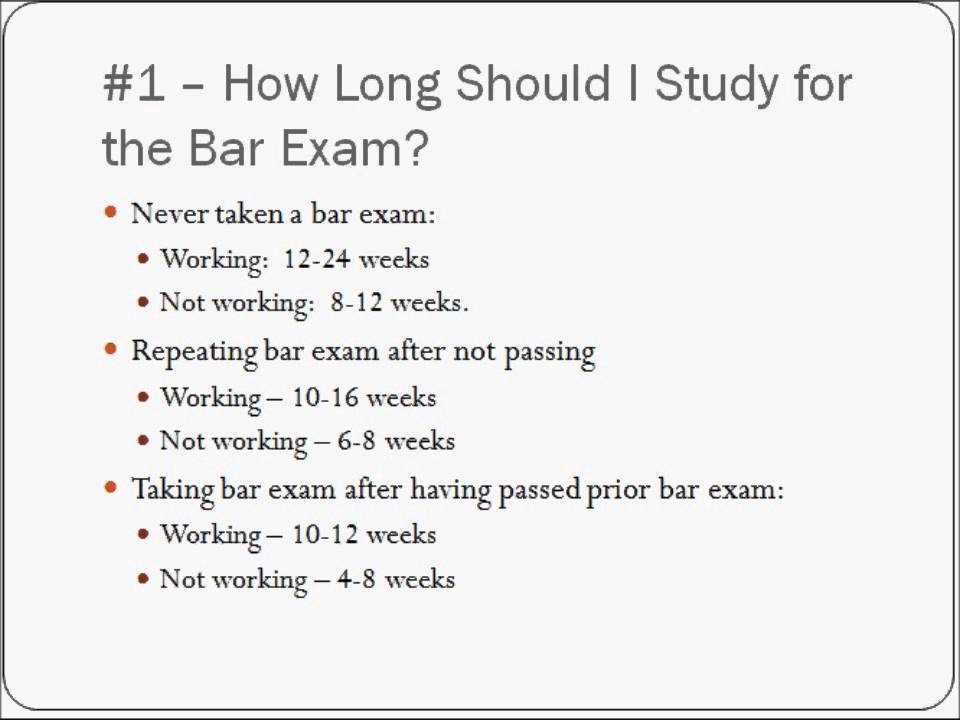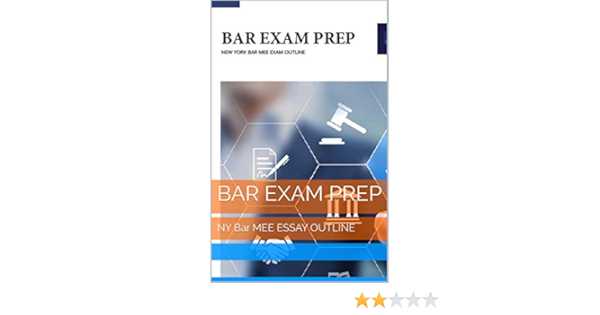
Preparing for the New York legal assessment requires not only knowledge of the law but also the ability to express that knowledge clearly and persuasively. The written portion of this process tests your ability to analyze complex legal issues and present coherent arguments within a limited time frame. To succeed, candidates must demonstrate precision in their reasoning, as well as the ability to structure their responses logically.
Effective preparation involves understanding the structure of the tasks, honing writing skills, and practicing time management. Success hinges on your ability to address each question with clarity, presenting both relevant legal principles and sound reasoning. The key is to develop a strategy that allows you to navigate the challenges of writing under pressure while maintaining a high level of detail and accuracy.
Whether you are tackling hypothetical scenarios or applying specific legal doctrines, developing a systematic approach to writing will help you effectively communicate your analysis and increase your chances of success. With the right techniques and ample practice, you can master this essential aspect of the New York legal assessment.
Essential Tips for Legal Test Success
Achieving success in the written portion of the New York legal assessment requires a combination of preparation, strategy, and strong analytical skills. Understanding how to approach the tasks effectively can make a significant difference in performance. Developing a clear and methodical approach to each question is crucial for demonstrating your ability to handle complex legal issues under time constraints.
Effective Time Management
One of the most important skills to master is time management. Each response has a limited amount of time, and efficiently organizing your thoughts is key. Begin by allocating a set amount of time to outline your response, ensuring that you can address all critical points without rushing through the analysis. Avoid spending too much time on any one section, as balancing your attention across multiple tasks will yield better results overall.
Focus on Clear Structure and Analysis
Clear structure is vital for presenting a strong argument. Ensure that your responses follow a logical progression, from identifying the issue to applying the relevant law and offering a well-supported conclusion. The clarity of your analysis will be judged alongside your legal knowledge, so strive to break down complex topics into manageable components. Strong introductions and concise conclusions can enhance the readability and impact of your responses.
Understanding the NY Legal Assessment Format
In order to succeed in the written section of the New York legal evaluation, it’s crucial to familiarize yourself with its structure and requirements. The format of the tasks is designed to assess both your knowledge of the law and your ability to apply that knowledge effectively within a set time frame. Understanding how the questions are organized will help you navigate the challenges and manage your time more efficiently.
The assessment consists of multiple sections, each focused on different aspects of legal analysis. You will be required to respond to hypothetical situations where you must identify legal issues, analyze applicable laws, and provide coherent and well-supported conclusions. The key to performing well is to approach each question systematically and ensure that your responses are structured clearly and logically.
Familiarizing yourself with the format beforehand will allow you to practice more effectively and avoid surprises on the day of the test. Knowing the number of questions, the time allotted for each, and the general content areas covered will enable you to allocate your time wisely and approach the tasks with confidence.
Key Skills for Writing Legal Responses
To succeed in the written portion of the New York legal assessment, it’s essential to master several key skills that will enable you to craft strong, clear, and well-structured responses. The ability to analyze complex legal issues, apply relevant laws, and communicate your thoughts effectively is crucial. These skills not only demonstrate your knowledge but also your ability to think critically under pressure.
One of the most important skills is legal analysis. You must be able to identify the core issues presented in each question and apply the appropriate legal principles. Another critical skill is organization. A clear and logical structure helps ensure that your argument is easy to follow, with a strong introduction, body, and conclusion. Additionally, practicing concise writing is vital, as you need to convey complex legal concepts in a straightforward manner, making your points clearly and persuasively within a limited word count.
Time Management During the Evaluation
Effective time management is crucial for success in the written portion of the New York legal assessment. With multiple questions to answer within a limited time frame, it’s important to allocate your time wisely to ensure you can address each task thoroughly without rushing. Developing a strategic approach to time allocation will allow you to maximize your performance.
Start by setting specific time limits for each question, and stick to them. Begin with a brief outline to organize your thoughts, which will help you stay on track and avoid wasting time on unnecessary details. Prioritize key points and ensure that your responses are well-rounded, addressing all relevant aspects of the issue at hand. If you find yourself spending too much time on one question, move on to the next and come back later if needed. By practicing effective time management, you will improve both the quality and efficiency of your responses.
How to Analyze Legal Prompts
Analyzing the prompts effectively is essential to crafting strong responses. Each question is designed to test your ability to identify legal issues, apply relevant rules, and construct well-reasoned arguments. The first step in tackling a prompt is to thoroughly read and understand what is being asked before diving into your analysis.
Begin by identifying the key facts and issues presented in the prompt. Look for important details that highlight the legal questions you need to address. Once the issues are clear, think about the relevant laws and principles that apply to those issues. It’s important to break down the prompt into manageable parts, organizing your response logically to ensure that each point is covered comprehensively. By practicing this structured approach, you will develop a systematic way of addressing prompts and improve your ability to respond accurately and efficiently.
Common Pitfalls to Avoid in Legal Responses
When tackling the written portion of the New York legal assessment, there are several common mistakes that can undermine the effectiveness of your responses. Being aware of these pitfalls and taking steps to avoid them will improve the clarity and quality of your work. It’s essential to stay focused, maintain structure, and ensure that every point is addressed with precision.
Failure to Address the Question Directly
One of the most frequent errors is not answering the question as it is asked. Many candidates get caught up in presenting irrelevant information or discussing aspects of the law that don’t directly apply to the scenario at hand. To avoid this:
- Carefully read the prompt to ensure you understand what is being asked.
- Stay focused on the specific issues raised in the question, addressing each one directly.
- Don’t include unnecessary details or tangents that do not contribute to the solution.
Weak Organization and Structure
Another common mistake is a lack of clear structure in the response. Disorganized writing can make it difficult for the reader to follow your analysis. To ensure clarity:
- Use a logical framework such as the IRAC (Issue, Rule, Application, Conclusion) method to structure your answer.
- Keep paragraphs focused and concise, each one addressing a single point.
- Start with a brief outline to map out your main arguments before writing.
Ignoring Time Constraints
It’s easy to spend too much time on one section, but this can lead to rushed or incomplete responses later. To manage your time better:
- Allocate a set amount of time to each question.
- Stick to your time limits and avoid overthinking one section.
- If you’re running out of time, move on to the next question and come back if necessary.
Structuring Your Response Effectively
A well-organized response is essential for conveying your legal analysis clearly and persuasively. The structure of your answer not only helps you stay focused but also ensures that your argument flows logically from one point to the next. A strong, clear structure can make a significant difference in how your answer is perceived and understood.
Start by planning your response before writing. This will help you allocate time to each part of the analysis and ensure you don’t miss important details. Here’s a suggested structure:
Introduction
- Briefly restate the issue presented in the prompt to confirm your understanding.
- Provide a roadmap for your response, outlining the main points you will address.
Body of the Response
- Divide your analysis into clear, manageable sections, each addressing a specific issue or element of the law.
- Apply the relevant rules to the facts presented in the prompt, offering analysis and reasoning for each point.
- Stay focused on the legal issues and avoid going off-topic or over-explaining unrelated concepts.
Conclusion
- Summarize the key points of your analysis and provide a concise conclusion that addresses the overall question.
- Be clear and direct, avoiding unnecessary repetition or excessive detail.
Mastering Legal Analysis in Responses
Effective legal analysis is at the core of a successful response. The ability to break down complex issues, apply the relevant law, and provide a well-supported conclusion is essential. Mastering this skill will allow you to demonstrate both your legal knowledge and your critical thinking abilities under pressure.
To approach legal analysis effectively, it’s important to follow a structured process. Begin by clearly identifying the issue, then apply the relevant legal rules, and finally, analyze how those rules apply to the facts at hand. This structured approach ensures that you cover all aspects of the prompt and provide a thorough analysis.
Key Steps in Legal Analysis
| Step | Explanation |
|---|---|
| Issue Identification | Clearly state the legal issue presented in the prompt, ensuring you understand what is being asked. |
| Rule Application | Identify the applicable laws or legal principles and state them clearly, ensuring relevance to the issue. |
| Analysis | Apply the rules to the facts of the scenario, offering a detailed analysis of how the law applies to the situation. |
| Conclusion | Provide a concise and well-reasoned conclusion based on your analysis, summarizing your findings. |
By mastering these steps, you will be able to present a comprehensive, organized, and persuasive argument in your responses, increasing your chances of success in the legal assessment.
How to Use the IRAC Method

The IRAC method is a structured approach to answering legal questions that ensures clarity and completeness. This technique breaks down your response into four distinct parts: Issue, Rule, Application, and Conclusion. Using this method helps you focus on the most relevant points, organize your analysis logically, and present a clear, persuasive argument.
Each step of the IRAC method plays a critical role in crafting an effective response:
Issue
Start by identifying the legal issue at hand. Clearly define the problem that needs to be addressed, and make sure you understand the core question being asked. This step sets the foundation for your entire analysis, so it’s essential to phrase the issue precisely.
Rule
Next, state the relevant laws, rules, or principles that apply to the issue. This section should be concise but thorough, providing the legal framework that will guide your analysis. Make sure the rules you reference are applicable to the specific facts presented in the prompt.
Application
In the application section, you apply the legal rules to the facts of the scenario. Analyze how the rules impact the situation, explaining how each relevant factor influences the outcome. This is the most critical part of your response, as it demonstrates your ability to think critically and apply legal principles effectively.
Conclusion
Finally, conclude your analysis by summarizing your findings. Based on your application of the law, provide a clear and reasoned conclusion that answers the central question. Ensure that your conclusion follows logically from your analysis and is fully supported by the facts and rules you’ve discussed.
Using the IRAC method helps you stay organized and ensures you cover all the necessary components of a comprehensive legal response. By mastering this approach, you can write clear, structured, and effective answers under timed conditions.
Improving Your Legal Writing Skills

Effective legal writing is an essential skill for any aspiring legal professional. The ability to communicate complex legal concepts clearly and concisely is key to crafting persuasive responses that are both accurate and well-organized. Improving this skill involves practice, attention to detail, and an understanding of the principles that underpin strong legal writing.
To enhance your writing, it’s important to focus on clarity, precision, and structure. Organize your thoughts logically, avoid unnecessary jargon, and make sure each sentence contributes to your overall argument. The goal is to present your analysis in a manner that is easy to follow and compelling to the reader.
Key Strategies for Effective Writing
- Be Clear and Concise: Avoid overly complex language and convoluted sentence structures. Keep your writing straightforward and to the point.
- Use Proper Legal Terminology: While clarity is important, it’s also essential to use the correct legal terms. This demonstrates your understanding of the law and ensures accuracy in your analysis.
- Maintain Logical Flow: Organize your response in a way that makes sense to the reader. Use headings, subheadings, and transitional phrases to guide the reader through your analysis.
- Focus on Structure: A well-structured answer is key to communicating your ideas effectively. Make sure each section has a clear purpose and contributes to answering the question.
Practicing and Refining Your Skills
Improvement comes with consistent practice. Regularly write practice responses, review feedback, and refine your technique. Additionally, reading well-written legal documents and analyzing how arguments are presented can provide valuable insights into how to enhance your own writing. By applying these strategies and continuously seeking to improve, you can develop the legal writing skills necessary for success.
Effective Use of Legal Precedents
Legal precedents play a crucial role in shaping legal arguments and supporting claims. By referencing past court decisions, you can strengthen your analysis and demonstrate your understanding of how the law has evolved. Properly incorporating precedents into your responses helps establish credibility and shows your ability to apply established legal principles to current scenarios.
To use precedents effectively, it’s important to not only cite relevant cases but also explain how they apply to the issue at hand. A strong precedent-based argument will include a clear connection between the past case and the facts in your current analysis, showing why the precedent is applicable and how it supports your conclusion.
How to Integrate Precedents into Your Analysis
- Select Relevant Precedents: Choose cases that directly address the issue you are discussing. Avoid overloading your response with irrelevant or tangential precedents.
- Explain the Legal Rationale: Don’t just mention the case; explain the reasoning behind the court’s decision and how it impacts the present situation.
- Analyze Similarities and Differences: Highlight the key similarities between the precedent and your facts, as well as any differences that may affect the application of the rule.
- Use Precedents to Strengthen Your Argument: Ensure that the precedent supports your conclusion by clearly connecting the facts of the previous case with the current situation.
Common Pitfalls to Avoid
- Misapplying Precedents: Avoid using a precedent in a way that misrepresents its holding or significance. Ensure that the facts and legal principles align.
- Overuse of Precedents: Citing too many precedents can overwhelm the reader. Focus on the most pertinent cases and avoid excessive citation.
- Ignoring Jurisdictional Differences: Be cautious when using precedents from different jurisdictions, as their relevance may vary depending on the jurisdiction of the issue at hand.
By carefully selecting and analyzing legal precedents, you can significantly enhance the quality of your argument and demonstrate a sophisticated understanding of legal principles.
Tips for Answering Hypothetical Questions
Hypothetical questions challenge you to apply legal principles to a set of fictional or theoretical facts. The key to answering these questions effectively is to stay focused on the details presented in the scenario while maintaining a clear and structured approach to your analysis. By carefully breaking down the question and following a methodical process, you can construct a persuasive and well-reasoned response.
When addressing hypothetical questions, it’s crucial to recognize the specific issues at play and how they relate to the relevant legal rules. It’s not only about stating the law but also about explaining how it applies to the given facts and outlining the possible outcomes based on different interpretations or applications of the law.
Steps for Structuring Your Response
- Identify the Key Issue: Focus on the central legal issue raised by the hypothetical scenario. Be precise in recognizing what needs to be addressed.
- Apply the Relevant Law: Refer to the applicable legal rules or precedents that are relevant to the issue at hand. Make sure to apply them directly to the facts presented.
- Consider Multiple Perspectives: Hypothetical scenarios often involve complex or ambiguous facts. Evaluate the situation from different angles and anticipate potential arguments for and against each possible outcome.
- Provide a Well-Reasoned Conclusion: Conclude by synthesizing the information and offering a clear, logical answer to the question. Ensure that your conclusion is fully supported by the legal analysis you’ve provided.
Common Mistakes to Avoid
- Overlooking Key Facts: Always pay attention to the facts provided. Small details can significantly impact the legal analysis and the outcome of your argument.
- Failing to Support Your Argument: Simply stating an answer is not enough. Always back up your conclusions with clear reasoning and applicable legal principles.
- Relying Too Heavily on Theory: While theoretical knowledge is important, make sure to ground your response in practical application to the facts provided. Avoid abstract or overly general answers.
By following these steps and avoiding common pitfalls, you can approach hypothetical questions with confidence and present a thoughtful, well-structured response that demonstrates your ability to think critically and apply legal reasoning effectively.
Building Confidence for the Exam
Confidence is key when preparing for any major assessment. It’s not just about knowing the material; it’s about believing in your ability to apply what you’ve learned under pressure. Building confidence for a rigorous test requires strategic planning, focused practice, and mental preparation. By taking proactive steps to boost your self-assurance, you can perform at your best when it matters most.
One of the most effective ways to build confidence is through repetition and exposure to the types of questions you will face. Familiarity with the format and expectations of the test can reduce anxiety and give you a clearer sense of what to expect. In addition, practicing regularly under timed conditions can help you refine your time management skills and boost your comfort level.
| Strategies for Confidence Building | Benefits |
|---|---|
| Regular Practice | Improves familiarity with the question format and enhances problem-solving skills. |
| Mock Tests | Simulates test conditions, helping you manage time and stress more effectively. |
| Study Groups | Encourages collaborative learning, which can reinforce understanding and boost morale. |
| Self-Assessment | Identifies areas of strength and weakness, allowing for focused improvement. |
By actively engaging in practice sessions and seeking feedback from peers or mentors, you can gradually develop a sense of mastery over the material. In addition, incorporating relaxation techniques, such as deep breathing exercises or mindfulness, can help manage stress and maintain a clear, focused mindset on test day.
Ultimately, confidence is built on consistent effort, preparation, and a positive mindset. The more prepared you feel, the more confidently you can approach the assessment and tackle each question with clarity and focus.
How to Review Your Essay Responses
Reviewing your responses after completing an assessment is a critical step in improving your performance. It allows you to identify areas where you may have missed important details or where your analysis could be more clearly articulated. The review process helps ensure that your arguments are well-supported and that your answers fully address the questions presented. By carefully analyzing your work, you can refine your skills and improve your future responses.
When reviewing your written answers, it’s essential to look beyond just spelling or grammar mistakes. Focus on the structure, clarity of thought, and depth of legal analysis. Did you fully address all aspects of the question? Is your reasoning logically sound, and have you supported your claims with appropriate evidence or legal principles? A thorough review helps you identify strengths and weaknesses, which are crucial for long-term improvement.
Key Areas to Focus On During Review
- Clarity and Organization: Ensure that your response is well-structured, with clear transitions between paragraphs. A well-organized response is easier to follow and more persuasive.
- Comprehensive Analysis: Check if you have covered all relevant legal issues and applied the appropriate rules to the facts. Don’t overlook any key points.
- Conciseness: Avoid unnecessary repetition or overly complex language. Your response should be concise while still being thorough.
- Supporting Evidence: Verify that your arguments are backed by appropriate legal precedents, statutes, or case law. Unsupported claims are weak and less convincing.
Common Mistakes to Look For
- Vague or Incomplete Answers: Ensure you have answered all parts of the question. Leaving out important details can significantly reduce your score.
- Overlooking Counterarguments: A well-rounded response should acknowledge potential opposing viewpoints and explain why your position is stronger.
- Failure to Follow the Question’s Instructions: Double-check that your answer is aligned with the instructions. Sometimes, small deviations can negatively impact the quality of your response.
After reviewing your responses, make any necessary revisions to enhance clarity and depth. Practicing this process will improve both your confidence and performance in future assessments.
Practice Essays and Feedback
Regular practice and receiving constructive feedback are essential elements in mastering any writing task. By completing practice responses, you familiarize yourself with the type of questions you may face and refine your skills. However, the most significant gains come from incorporating feedback. Whether it’s from peers, instructors, or self-assessment tools, feedback offers valuable insights into your strengths and weaknesses, helping you improve over time.
When practicing, it’s important to focus on both the process of writing and the analysis of the feedback received. Constructive criticism not only identifies areas of improvement but also reinforces effective strategies. With each piece of feedback, you gain a clearer understanding of what is expected and how to approach your responses more effectively.
How to Use Feedback Effectively

- Focus on Repeated Issues: If certain mistakes or weaknesses are highlighted repeatedly, it’s crucial to address them in subsequent practice sessions. This helps eliminate recurring errors.
- Understand the Rationale: Make sure to understand why specific feedback is given. Understanding the reasoning behind corrections will allow you to adjust your strategy in a more meaningful way.
- Keep Track of Your Progress: Document your practice sessions and feedback to monitor your development. This provides insight into how much you’ve improved and what areas still require attention.
Using Practice to Build Confidence

Regular practice not only improves technical skills but also boosts confidence. By simulating real tasks and facing diverse scenarios, you build a familiarity with the types of challenges you might encounter. With each piece of feedback, you see where you’ve grown, which reinforces your ability to perform well under pressure.
| Practice Focus | Feedback Objective |
|---|---|
| Time-bound writing exercises | Assess time management and clarity |
| Review of multiple scenarios | Evaluate depth of analysis and argumentation |
| Simulating real assessment conditions | Check coherence and organizational structure |
By consistently practicing and applying feedback, you will enhance both your writing and analytical abilities, ultimately ensuring you’re well-prepared for any challenge you face.
Staying Focused During the Exam
Maintaining concentration throughout a lengthy writing task is essential for success. The ability to stay focused under pressure ensures that your thoughts are clear and your responses are thorough. Distractions can easily derail your performance, but with the right strategies, you can maintain mental clarity and focus for the duration of the assessment.
To keep your attention sharp and your writing effective, it’s crucial to manage both your mental and physical energy. This involves adopting techniques that reduce stress, increase productivity, and maintain momentum throughout the task. Below are some practical tips to help you stay on track.
Effective Focus Strategies
- Break the Task into Sections: Tackle the task in smaller, manageable sections. This prevents feeling overwhelmed and allows you to focus on one part at a time.
- Stay Organized: Use a clear outline or structure to guide your writing. An organized approach reduces mental clutter and helps maintain clarity.
- Practice Mindfulness: Taking brief moments to refocus can help reset your concentration. Deep breathing exercises or pausing for a few seconds can recharge your mind.
Minimizing Distractions
- Manage Your Environment: If you’re taking the task in a setting with distractions, make sure it’s as quiet and comfortable as possible. Eliminate any unnecessary noise or interruptions.
- Stay Physically Comfortable: Sitting in a comfortable, ergonomic position can help you avoid physical discomfort, which could detract from your ability to concentrate.
- Time Management: Set specific time limits for each section to keep yourself from dwelling too long on any one point. This ensures you maintain a steady pace.
By staying focused and applying these strategies, you can maximize your performance and stay productive throughout the writing process. The key to success is balancing time, attention, and energy effectively.